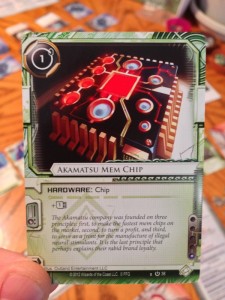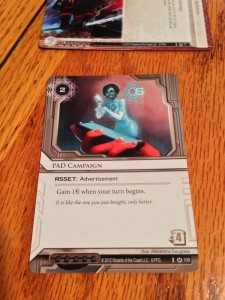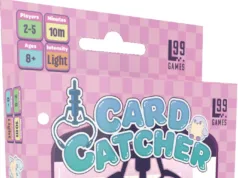 Android: Netrunner debuted to much acclaim at Gen Con 2012. It was actually a remake of the Netrunner Collectible Card Game (CCG) that came out in the mid 90s. This time, Fantasy Flight Games decided to make Netrunner a Living Card Game (LCG) instead of a CCG. I was pretty excited for this change, as I hate the money-sinks that CCGs can turn into. So props to Fantasy Flight for saving me a few dollars.
Android: Netrunner debuted to much acclaim at Gen Con 2012. It was actually a remake of the Netrunner Collectible Card Game (CCG) that came out in the mid 90s. This time, Fantasy Flight Games decided to make Netrunner a Living Card Game (LCG) instead of a CCG. I was pretty excited for this change, as I hate the money-sinks that CCGs can turn into. So props to Fantasy Flight for saving me a few dollars.
Android: Netrunner is a game set in the cyberpunk Android universe (Android, Infiltration). It’s a card game for 2 players that takes about 45 minutes to play. In Netrunner, 2 players do battle with unique asymmetrical game play mechanics. While it was designed by Richard Garfield (creator of Magic: The Gathering), Netrunner plays almost nothing like MTG. Most CCGs or LCGs borrow some influence from Magic, but not Netrunner. It’s a completely new and amazing game.
Game Overview:

In Netrunner, one person takes on the role of the powerful Corporation who is trying to advance their agendas, while the other player is the runner, a hacker, who must steal the Corporation’s agendas.
One of the defining features of Netrunner is its asymmetrical game play. I say the game play is asymmetrical because both players play the game quite differently. Each player will have different cards, objectives and even play areas. The Corp must install agendas and other cards in its servers, and then protect those with ICE cards (defense cards). The runner installs computer hardware and programs that it will use to break into the corporations servers by making runs (hacking attempts).
Netrunner is a very strategic card game. Every action you take in the game will matter. In fact, it would be a rare turn where you feel you have extra actions to burn. Players have a lot of control over everything that happens in Netrunner.
The other facet of the game is an optional one: Deck building. Deck building allows the corporation or runner to customize their play deck to their liking. Much like you would build your deck in Magic: The Gathering, you can customize your card deck in Netrunner. For those not interested in deck building, the standard decks that come with the base game work just fine.
Components:

First off, the artwork in Netrunner is just gorgeous. The artists that Fantasy Flight hired did an amazing job. Netrunner practically oozes its theme. The cards are laid out in the standard CCG format, large image on top, relevant text on the bottom. You don’t have to be a fan of the cyberpunk genre to enjoy this game. However if you do, then Netrunner will be right up your alley. There is also a number of cardboard tokens included that will be used throughout the game.
One thing that I wish Fantasy Flight had included is a play mat. In most card games, you just drop cards in front of you. With Netrunner, every card has to be played in a specific spot in relation to other cards. Having a play mat that shows you what cards to play and where would be incredibly helpful in teaching new people how to play the game.
How to Play:
Netrunner is a game that benefits from each player knowing what they are doing. Fantasy Flight didn’t do the best job with their rulebook and it will take some time to learn this game without a teacher. That being said, I’ll try and give you an overview of what each side will be doing. Although if you really want to learn how to play, I’d recommend one of the many teaching videos available on YouTube.
As the Corporation player, your main job is to advance your agendas, all while holding off the runner’s attacks. The Corporation gets 4 clicks (Actions) per tun. The first of which must be used to draw a card. Clicks can be spent on various activities like installing (playing) cards, earning credits (used for purchases), drawing more cards or advancing agendas (how you win).
The Corporation plays its agenda cards face down. Then, to protect them, they play ICE cards facedown in front of the agendas. ICE cards are the only thing that stops the runner from getting easy access to the agendas. But that’s not the only thing the runner can access. They can also attack your draw deck, your hand and even your discard pile. I must admit, I was pretty shocked by this mechanic, as I don’t know of many games where you have to protect your hand and draw deck, but in Netrunner, it works really well.

As for the runner, they get 4 clicks per turn as well (although without the draw restriction the corporation has). The runner’s clicks can be used on various actions like: Drawing cards, earning credits, installing hardware or making a run. Running is the central part of the game. Running is essentially the player trying to hack into the corporation’s servers. Its the runs where a runner may score the corporation’s agendas or trash their resources.
To make a run, the runner chooses a target (face down server cards, draw deck, the corporation’s hand and discard pile are all valid choices). Once the run begins, the corporation has a chance to use any ICE cards they’ve played to stop the runner. To get past those dangerous ICE cards, the runner must use their own program cards to attempt to bypass them (in the form of Icebreaker cards or Viruses). If they succeed in making it past the corporations ICE cards, they can then access their target. If it’s an agenda, they score it and are one step closer to winning. If they get stopped in their run, their action is over, sometimes with rough consequences.
Play alternates back and forth along those lines until someone wins. The Corporation’s job is fairly straight forward as all the information is open and available to him. His game is one of bluff and deception. Since most of his cards are played face down, the runner will only have ideas of what those cards might be. The runner needs to be a risk taker. He has to play with his gut. Chances are he will be making his runs against at least a few unknown cards. His best bet is to try and cover all his basis before making a run, but that won’t always be possible. Wait too long for the right card and it might already be too late.
Game Experience:

My first game of Netrunner was a little rough as we were both learning for the first time. I feel as if Fantasy Flight made the learning curve a lot steeper then it needed to be with the way they handled the rule book. While Netrunner does a great job with its theme, but the terminology they used is not very intuitive. Instead of actions, you have clicks. Instead of playing a card, you install a card. Your hand of cards is either your HQ (for the corp) or your Grip (for the runner). Flipping a card face up is called “rezzing a card”. While these names help keep the game in the theme, they make learning the game a little harder as you have to learn and remember new terminology.
But that’s also my biggest gripe with the game. It will probably take you at least 1 or 2 games before you start to feel comfortable with Netrunner. This is a game about secrecy, bluffing and strategy. The game will flow a lot better once both players have a good grip on the rules.
However, once you actually understand the game play, Netrunner sucks you in pretty deeply. I haven’t decided yet if I prefer playing as the Corporation or the Runner. Both play differently and have their positive aspects.
The Corporation has all of the information in the game. Only you know what’s under those face down cards. You can install your agenda in that new server, or you can put a trap in there for the runner. You can defend it fiercely with ICE cards or you can defend it lightly in hopes that the runner will fall into your trap. More than once we had an exchange like this:
“Ok, I am making a run against that server”
“Really? OK, if that’s what you want to do”
“What? Why…”
“No reason, go for it. <big smile >”
“Actually, I am making a run against your hand instead…jerk”
If you like head games, or the feeling that you are in control of everything, you’ll really enjoy playing the corporation.

The Runner takes a little while to get built up. You start off with no hardware or programs, so it takes time to find the right programs/hardware and get everything installed. And while you are taking your time building up credits and getting those Icebreakers installed, the Corporation is building up their defenses as well. Run too early and you might be unprepared for the Corporation’s defense. Wait too long and the Corporation will have scored too many agendas. It’s a fine line the runner has to walk.
A runner has to be a bit of a risk taker. Since most of the time, you will be making your runs against face down cards, you won’t know if you have all of the tools you’ll need, or even if the card you are targeting is worth it. This adds a good amount of tension to this role, but also some excitement.
So in the end, you have a giant game of Cat and Mouse between the 2 players. Its fun, exciting and somewhat nerve wracking. I’ve had more than one action as the runner where I’ve spent a large amount of resources to get through to the corporations servers, only to have it be a worthless card. I threw the card down in frustration, but immediately started plotting my next action. However, when you do make it through the corporation’s ICE and find that well protected agenda, it’s incredibly satisfying.
The players also have a lot of control over what’s happening in the game. You can feel when you are falling behind in the game. If a runner looks across the table and see row after row of ICE cards and a large pile of credits, they know things aren’t looking good. However, Corporation player knows things aren’t going well if they are constantly on their heels, and losing cards to the runner’s attacks. There is an ebb and flow to the game at the start, but eventually, one player will start to pull ahead.
Luck plays a good part in any card game, but it’s somewhat minimal in Netrunner. You have so many different actions per turn, you can mitigate almost any disadvantage that luck would cause.
Final Thoughts:

After only a few plays, it wasn’t hard to figure out why Netrunner sold out so quickly at Gen Con. They did an amazing job with this game. The artwork is great and the game balance is almost perfect. Throughout our games, it was rare for one side to easily roll to a victory. Almost every game was a cutthroat battle where the winner wasn’t decided until the very end. Every new game now is increasingly cutthroat as we get more familiar with the roles and the rules of the game.
When I first heard about Netrunner, I wasn’t sure how much it was going to interest me. The theme was great, but my quick overviews of the game play didn’t excite me. Boy was I wrong. I am having a blast playing Netrunner. Not game has made it to the table as much as Netrunner has in the past few months. After every play, you realize things you’ve done wrong and want to play again to see if you can improve.
The asymmetrical game play also adds a lot of replay to the game. You can spend dozens of games working out your runner strategy and building that perfect deck. However, once you start playing the Corporation, all your runner experience goes out the window. Both sides play so differently, that you’ll need to start building up your strategy from the beginning again. It’s a great concept that will have you coming back again and again.
Once you can get past the learning curve for Netrunner, I think there is a lot of enjoyment to be had. Fantasy Flight did a lot right with this game. The turns are quick, the strategy is very deep and the game play only takes about 45 minutes. These factors completely outweigh my few minor gripes with the game. I’m looking forward to my next play and am already considering getting more into deck building. Time to get some more cards!
If you are interested in getting a copy for yourself, it’s about $30
Final Score: 5 Stars – A card game with a great them, very unique game play and almost perfect balance. Netrunner keeps you coming back for more.
 Hits:
Hits:
• Asymmetrical is very unique and a great decision
• Gorgeous artwork
• Fun theme that works very well with the game concept.
• Fantastic game play balance
Misses:
• Rulebook isn’t the best and the learning curve is somewhat high
• Unique terminology adds to the learning curve






















This game is a lot of fun, but it requires a BIG time investment in learning all the rules. It’s great for 2 players because, although many games allow for a 2 player option, they usually aren’t very good with 2 players. This one is great for 2 people who are willing to invest some time to learn it.
This game sounds great. I’m a big fan of cyberpunk, which really helps. Thanks for sharing/reviewing for us!
Yeah, you definitely need to make a big time investment in learning the rules. It seems like the rules could be simplified quite a bit without losing much/any of the game theme. Oh well, it is pretty sweet once you learn it and it really makes you feel like a hacker or corporate IT security guy!